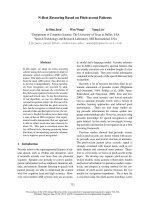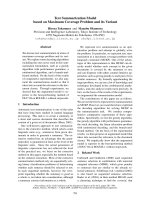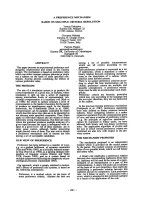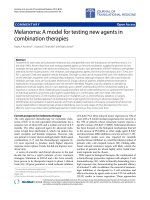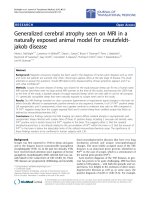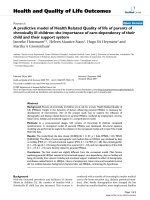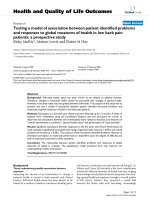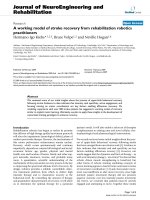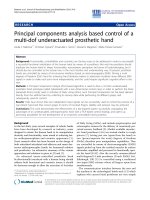Báo cáo hóa học: " Intrusion detection model based on selective packet sampling" ppt
Bạn đang xem bản rút gọn của tài liệu. Xem và tải ngay bản đầy đủ của tài liệu tại đây (778.4 KB, 12 trang )
RESEARCH Open Access
Intrusion detection model based on selective
packet sampling
Ezzat G Bakhoum
Abstract
Recent experimental work by Androulidakis and Papavassiliou (IET Commun 2(3):399, 2008; IEEE Netw 23(1):6, 2009)
has shown that it is possible to maintain a high level of network security while selectively inspecting packets for
the existence of intrusive activity, thereby resulting in a minimal amount of processing overhead. In this paper, a
statistical approach for the modeling of network intrusions as Markov processes is introduced. The theoretical
findings presented here confirm the earlier experimental results of Androulidakis and Papavassiliou. A common
notion about network intrusion detection systems is that every packet arriving into a netw ork must be inspected
in order to prevent intrusions. This investigation, together with the earlier experimental results, disproves that
notion. Additional experimental testing of a corporate local area network is reported.
Keywords: Network Intrusion, Intrusion Detection System, IP Packets, Markov Process, Birth and Death Model
1. Introduction
Network intrusion detection systems (IDS) perform a
vital role in protecting networks connected to the
World Wide Web from malicious attacks. Traditionally,
IDS software products such as SNORT [1], SecureNet
[2], and Hogwash [3] work by monitoring traffic at the
network choke-point, where every incoming IP packet is
analyzed for suspicious patterns that may in dicate hos-
tile activity. Because those software systems must match
packets against thousands of known ominous patterns,
they must work extremely fast. Under heavy traffic,
however, the IDS is usually forced to drop packets so
that the IDS itself will not become the bottleneck of the
network, of course at the risk of allowing an attack to
go undetected. Because of this deficiency, host-based
IDS solutions have been introduced [4,5]. Host-based
IDS products run on a server rather than at the network
gateway. Unfortunately, however, host-based solutions
can slow down the server considerably under heavy traf-
fic conditions. Because of the inherent limitations of all
software solutions, hardware solutions were finally intro-
duced. The state-of-the-art hardware solution is a field
programmable gate array (FPGA) that performs the
same IDS function at substantially higher speeds [6,7].
There are serious other problems, however, to contend
with when hardware solutions are implemented [7].
The purpose of this paper is to introduce an analytic
and statistical mode l for the process of network intru-
sion and to demonstrate that the common notion of the
necessity of having the content of every IP packet
inspected is flawed. In the past, numerous research arti-
cles that addressed the problem of network intrusion
modeling have appeared in the literature [8-19]. Kephart
and White [8,9] published the first analytical work on
the modeling of the propagation of viruses and worms.
More recently, Wang and Wang [10], guided by the
analysis of Kephart and White, recognized that the pro-
blem of network intrusion can be modeled after the
popular “birth and death” epidemiological model. Wang
and Wang (WW), however, did not develop such a
model analytically, as the problem is mathematically
challenging. Very recently, an important experimental
dis covery was made by Androulidaki s and Papavassiliou
(AP) [11,12], when they demonstrated experimentally
that t he selective inspection of packets for the purpose
of detecting network intrusion can be as effective as the
full inspection of all packets. In this paper, it will be
demonstrated that the seemingly unrelated discoveries
of WW and AP do in fact stem from the same mathe-
matical origin. More specifically, the WW hypothesis
that the process of network intrusion can be modeled
Correspondence:
Department of Electrical and Computer Engineering, University of West
Florida 11000 University Parkway, Pensacola, FL, 32514, USA
Bakhoum EURASIP Journal on Information Security 2011, 2011:2
/>© 2011 Bakhoum; licensee Springer. This is an Open Access article distributed under the terms of the Creative Commons Attribution
License ( which permits unrestricted use, distribution, and reproduction in any medium,
provided the original work is properly cited.
after the “birth and death” epidemiological model will be
developed analytically for the first time. The results are
surprising and essentially confirm the experimental find-
ings of AP. The main conclusion is that it is possible to
selectively inspect packets from only certain packet
flows, thereby eliminatin g the speed bottleneck problem
and the necessity to drop packets at high bit rates, while
simultaneously maintaining a high degree of network
security.
Actual testing by the author that involved a corporate
local area network has confirmed the theoretical find-
ings. Additional testing of an optimized S NORT soft-
ware package–in combination with a traffic generator
and an Agilent network analy zer–has further confirmed
the theoretical findings. The implication of these theore-
tical and experimental results to the structure and the
design of future IDS will be quite substantial.
2. Statistical model of network intrusion
The analysis that will be now developed is based on the
observation that the birth and death mod el of network
intrusion that was advocated by Wan g and Wang i s a
class of Markov processes [20,21]. By applying Markov
chain analysis to the process of network intrusion, a sta-
tis tical formula that relates the probabil ity of a ne twork
being compromised to the probability of occurrence of
intrusion will be obtained. In the following sections, it
will be demonstrated that it is possible to selectively
inspect packets arriving into a network while maintain-
ing a high degree of security at the same time, as long
as such inspection is performed in accordance with the
statistical formula.
Consider an Intranet (such as a corporate LAN) that
is connected to the World Wide Web and protected
by means of a network intrusion detection system, as
shown in Figure 1. We shall assume that at any given
time the Intranet has a total of n processes, of which i
processes may be intrusive or hostile. We shall charac-
terize the network as being in state S
i
when i hostile
processes are running, state S
i-1
when i -1ofsuch
processes are running, etc. State S
0
will be therefore
the “clean” state, where no intrusive activity exists.
The first step toward modeling the process of intrusion
is to realize that the different states of the network can
be regarded as a set of mutually excl usive and collec-
tively exhaustive states. Furthermore, the transition of
the network from the present state to a different state
is a function only of the present state and the prob-
ability of transition to the next state. These character-
istics are the characteristics of Markov processes
[22,23]. Wang and Wang [10] recognized that the pro-
cess of network intrusion can be modeled after the
popular “birth and death” epidemiological model (a
class of Markov processes). Indeed, the birth and death
model has been applied in the past in a number of
other engineering problems of similar characteristics
[20,21]. The model is based on th e assumption that it
is equally likely for a system to make a transition from
state S
i-1
to state S
i
or from state S
i
to state S
i-1
.To
understand this fact, consider Figure 1. The i hostile
processes that are running on the network may initiate
a new hostile process, so that the number of such pro-
cesses becomes i + 1 (even without the occurrence of
external activity; e.g., an infected host on the network
that attempts to infect other hosts). Alternatively, a
hostile process may be terminated and the number
therefore drops to i - 1. In other words, it is equally
likely for a new hostile process to be started (born) on
the network or for an existing hostile process to be
terminated (die) and hence the name “birth and death”
model. This is the model that will be now adopted in
the present analysis. It is important to point out that if
the probability of the transition (S
i
® S
i-1
) is in fact
not equal to the probability of the transition (S
i-1
®
Figure 1 A network intrusion detection system inspects packets coming to a protected Intranet from the unprotected Internet.The
Intranet may have a total of n processes, of which i processes are intrusive or hostile. The hostile activity may originate externally or internally
from within the Intranet.
Bakhoum EURASIP Journal on Information Security 2011, 2011:2
/>Page 2 of 12
S
i
), the analysis presented here will not be altered, but
an additional constant of proportionality will simply
appear in the final equation. It is finally important to
point out that no assumption, explicit or implicit,
should be made about this generally complex problem
other than what is specifically described in the analysis
below. We shall now define four variables, let:
• b be the birth rate (or initiation rate) of new pro-
cesses on the network at any given time;
• d be the death rate (or termination rate) of
processes;
• P
i
be the probability that the network is in state S
i
;
• P
H
be the probability that any new process started
on the network be a hostile process. (This pro babil-
ity is an independent variable that strongly depends
on the circumstances. The numerical value of this
probability will be calculated a s described further in
Section 3).
Following the basic assumption of the equality of the
two transitions (S
i
® S
i-1
)and(S
i-1
® S
i
), this equality
can be written in terms of the above variables as follows:
i
n
dP
i
= bP
H
P
i−
1
(1)
where t he ratio i/n is the ratio of the number of hos-
tile processes to the total number of processes running
onthenetwork.Now,leta = b/d be the “workload
growth rate” at any given time. The above equation can
therefore be written as
P
i
=
n
i
α P
H
P
i−
1
(2)
from which we must conclude that n
P
1
=
n
1
α P
H
P
0
(3)
and
P
2
=
1
2
n α P
H
P
1
=
1
2
(nαP
H
)
2
P
0
(4)
(note that n is a general number that specifies the
total number of processes at any given state. It is there-
fore not appropriate to use n + 1 instead of n in the last
equation). Now P
3
will be given by
P
3
=
1
3
n α P
H
P
2
=
1
3
·
1
2
(nαP
H
)
3
P
0
(5)
Hence, for any state S
i
,
P
i
=
1
i!
(nαP
H
)
i
P
0
(6)
Equation (6) can b e alternatively and more rigorously
prov en using an inductive argument. Assuming that Eq.
(6) is valid for any value of i, if we replace i by i +1,we
have
P
i+1
=
1
(
i +1
)
!
(nαP
H
)
i+1
P
0
(7)
By similarly replacing i by i + 1 in Eq. (2), we have
P
i+1
=
n
i +1
α P
H
P
i
=
n
i +1
α P
H
1
i!
(nαP
H
)
i
P
0
=
1
(
i +1
)
!
(nαP
H
)
i+1
P
0
(8)
which is exactly the same as Eq. (7). Hence, Eq. (6) is
indeed valid for any value of i.
Given a maximum number i
max
of possible hostile
processes, where i
max
<n, and given that the set of all
“infected” states, together with the clean state, are col-
lectively exhaustive, we have the identity
i
max
i
=
0
P
i
=
1
(9)
From Eqs. (6) and (9), we now have
P
0
i
max
i
=
0
1
i!
(nαP
H
)
i
=
1
(10)
Since i
max
wouldnormallybealargenumber,the
summation approximates the infinite series
∞
i
=
0
x
i
i!
= e
x
(11)
Equation (10) can therefore be written as
P
0
e
nαP
H
=
1
(12)
or
P
0
= e
−nαP
H
(13)
The above equation gives the probability that the net-
work is in an intrusion-free state, P
0
, as a function of
the probability that any new process attempted on the
network might be a hostile process, P
H
. A plot of this
equation is shown in Figure 2 for different values of n,
where the workload growth rate a is assumed to be
equal to 1 (stable workload).
The number n in Eq. (13) and in the figure is the
number of processes initiated by users and does not
includesuchthingsassystemprocessesorbackground
tasks, since the p robability of occurrence of intrusion is
Bakhoum EURASIP Journal on Information Security 2011, 2011:2
/>Page 3 of 12
associated with user processes only. The inverse expo-
nential relationship of Eq. (13) is remarkable because, as
is well known, it can be practically approximated by a
linear function that drops to zero at a specific threshold.
For the n = 100 curve, for example, it can be easily con-
cluded that the inspection of all the incoming packets
will be inevitable if the probability of occurrence of
intrusion is larger than about 2%, as the probability of a
clean state is practically zero at all points past that
threshold. For P
H
< 2%, t he probability of a clean state
is substantial, and, as will be demonstrated in the fol-
lowing section, it is possible t o inspect packets selec-
tively under such conditions without sacrificing security.
This is clearly a better alternative to the strategy of
“inspect all packets, or drop packets randomly” that is
currently being implemented in IDS software solutions.
3. Optimization of network intrusion detection
systems
In view of t he abo ve, two questions must now be
answered: first, how the probability P
H
will be deter-
mined at any given time; and secondly, if P
H
is below
the threshold determined by Eq. (13), then what kind of
packet sampling strategy must be used to ensure that
intrusion would still be detected if it occurs.
a
In 2008,
Androulidakis and Papavassiliou [11,12] demonstrated
experimentally for the first time that under certa in con-
ditions, the selective inspection of packets for the pur-
pose of detecting network intrusion can be as effective
as the full inspection of all packets. We shall now
demonstrate th at the Andro ulidakis-P apavassiliou criter-
ion corresponds with the conclusions reached above.
3.1. The connection between P
H
and the Androulidakis-
Papavassiliou criterion
Androulidakis and Papavassiliou suggested that by selec-
tively inspecting packets and calculating the Shannon
entropy for the packets selected, a number that is indi-
cative of the likelihood of occurrence of intrusion is
obtained. The Shannon entropy H is defined as
H =
N
k
=1
P
k
log
2
1
P
k
(14)
where N is the number of packets inspected and P
k
is
the probability of occurrence of message k within the
stream of packets selected. The “messages” of concern
here are the following: the source IP address, the desti-
nation IP address, the source port, the destination port,
and the protocol. According t o [12]: “Entropy measures
the randomness of a data set. High entropy values sig-
nify a dispersed probability d ens it y function, while low
Figure 2 Probability that network is in clean state (P
0
) versus the probability of occurrence of intrusion (P
H
), for values of n ranging
from 20 to 100.
Bakhoum EURASIP Journal on Information Security 2011, 2011:2
/>Page 4 of 12
entropy values indicate a more concentrated distribu-
tion. For example, an anomaly such as an infec ted host
on the Internet that tries to infect other hosts (worm
propagation) results in a decrease of the entropy of the
source IP address. The infected machine produces a dis-
proportionately large number of packets, causing the
same source IP address to dominate in the distribution
of source IP addresses”. The entropy according to Eq.
(14) has a maximum value of log
2
N. In [12], the
entropy was “normalized” by dividing the expression by
log
2
N, so that it ranges from 0 to 1, that is
H(normalized) =
N
k=1
P
k
log
2
1
P
k
log
2
N
(15)
While the normalized entro py takes values in the
range (0,1), it is actually an inverse measure of the prob-
ability of occurrence of intrusion. As indicated above, an
intrusion attempt would actually cause the value of the
entropy of the source IP address to decrease. A value of
H that is close to 0 indicates a probability of occurrence
of intrusion that is close to 1 and vice versa. Hence, the
probability of occurrence of intrusion P
H
can be defined
in terms of H as follows:
P
H
=1− H(normalized) = 1 −
N
k=1
P
k
log
2
1
P
k
log
2
N
(16)
To test the theoretical predictions made in this paper,
b
a
number of tests that involved the network of a local
corporation were conducted. The first test was a test to
determine whether P
H
as defined by Eq. (16) correlates
with the results shown in Figure 2. In the test, the LAN
was subjected to traffic that emulates the propagatio n of
the Slammer worm [24] (additional details about the tests
are discussed in the following sections). The malicious
traffic consisted of a single UDP packet per destination IP
address, where the destination IP address was chosen ran-
domly. The source port of each UDP packet was also cho-
sen randomly, ranging from 1 to 65,535. The packets
arriving at the LAN were insp ected selectively, and the
value of P
H
was calculated from Eq. (16) at regular time
intervals. The number of user processes n running on the
LAN was purposely maintained at a constant value of
approximately 100. The result is shown in Figure 3.
As can be seen from the graph, the calculated value of
P
H
increased from less than 1% to more than 90% for a
time duration of approximately 1 min during which the
attack was simulated. This corresponds very well with
the data shown in Figure 2. Clearly, the formula in Eq.
(16) for calculating the instantaneous value of P
H
corre-
lates with the analysis of the previous section.
3.2. The principle of selective packet inspection
As suggested by Eq. (13) and Figure 2, full inspections
of all the packets should be implemented by the IDS if
the value of P
H
is above a calculated threshold, and
selective inspection is conceivably possible if P
H
is
below the threshold. Under heavy traffic conditions and
Figure 3 Value of P
H
as calculated from Eq. (16) for the source IP address and/or the destination port (worm propagation test).
Bakhoum EURASIP Journal on Information Security 2011, 2011:2
/>Page 5 of 12
low probability of occurrence of intrusion, such a solu-
tion is obviously very desirable. We shall now answer
the important question of wha t kind of packet sampling
strategy must be used to ensure that intrusion would
still be detected if it occurs. A number of studies ha ve
differentiated between packet-based sampling and flow-
based sampling [25-27]. In packet-based sampling, pack-
ets are selected from the global traffic using a pre-speci-
fied method. In flow-based sampling, packets are first
classified into flows. A “flow” is defined as a set of pack-
ets that have in common the following packet header
fields: s ource IP address, destination IP address, source
port, destination port, and protocol. The published stu-
dies, particularly the studies by Barford et al. [28] and
Sridharan et al. [29], have showed that small flows
(flows that consist of 1-4 packets) are usually the source
of most network attacks. Androulidakis and Papavassi-
liou have in fact advocated and demonstrated the suc-
cess of the selective inspection of packets from small
flows in their experimental investigation. According to
that approach, flows that consist of 1-4 packets are fully
inspected, and larger flows are inspected with a sam-
pling frequency that is inversely proportional to their
size (see ref. [11]). We now give a rigorous proof that
such a technique for the selective inspection of packets
guarantees that intrusion will be detected if it occurs:
Lemma: If the selective inspection of packets with a
sampling probability t hat favors small flows is imple-
mented, the probability of detecting a network intrusion
is approximately equal to 1.
Proof: Assume that the probability of any packet
selected being a malicious packet is P. If a total number
of N packets are selected, the probability of detecting at
least one malicious packet will be given by the Bernoulli
statistical trial probability [30]
P
detection
=
N
r
=1
N
r
(P )
r
(1 − P)
N−
r
(17)
For sufficien tly large N (e.g., N > 100) and sufficiently
large P (e.g., P > 0.01, or 1%), the above summation is
approximately equal to 1. If packets are selected predo-
minantly from small flows, P is guaranteed to be sub-
stantially higher than 1% (port scan, for instance, is only
one packet). ■
To summarize the above c onclusions, a modern, effi-
cient IDS should selectively inspect packets such that
small flows (flows that consist of 1-4 packets) are fully
inspected, and larger flows are inspected with a fre-
quency that is inversely proportional to their size. The
probability of occurrence of intrusion P
H
should be cal-
culated in real time by using Eq. (16). For calculating
P
H
, only the packet hea ders need to be inspected (see
the discussion in the previous section) and the
probabilities of occurrence of the source/destination IP
address, the source/destination port, and/or the protocol
must be calculated and used in Eq. (16). If at any time
P
H
exceeds a suitable threshold that is calculated from
Eq. (13), the IDS must switch immediately to the full
inspection of the content of all the packet traffic and
quarantine any packets that are found to be malicious.
3.3. Testing of the proposed IDS approach
The local area network of a small local corporation of 50
employees was used to test the IDS approach suggested
above. The experimental setup is shown in Figure 4.
As shown, malicious traffic was generated from a
Linux machine on which two differe nt packet-genera-
tion programs were installed: IDSWakeup [31] and D-
ITG [32]. These programs make use of the powerful
kernel of Linux to generate packets at speeds of up to
one Gigabit per second. The main purpose of IDSwa-
keup is to generate false intrusive attacks that mimic
well-known ones (e.g., Denial of Service (DoS) attacks,
port scan, and worm propagation), in order to deter-
mine how the IDS detects and responds to those
attacks. D-ITG (which stands for Distributed Internet
Traffic Generator), on the other hand, is a simple but
very versatile packet generator that can generate packets
of different sizes a nd different inter-departure times.
The packet-generation machine is equipped with a 3
GHz Pentium 4 processor, 4 GB of RAM, and a 1 Gb/s
network interface card. The malicious traffic generated
was merged with regular Internet traffic through a Cisco
router and directed to the corporate LAN, as shown. A
simple IDS software solution was developed for imple-
menting the inspection strat egy described above. The
code was developed in Matlab and converted to C (for
brevity, the details of the code will not be discussed
here). Essentially, the code inspects the headers of the
packets in small flows (flows that are 1-4 packets in
length). The headers of packets in larger flows are
inspected with a frequency that is inversely proportional
to the size of the flow, as des crib ed in the previous sec-
tion. After 100 packets are selected, the code computes
P
H
from Eq. (16), for 3 different attack scenarios: DoS,
port scan, and worm propagation. If P
H
is found to have
exceeded a suitable threshold that is calculated from Eq.
(13), the code immediately moves to full inspection
mode , where the actual contents of t he packets selected
and all subsequent packet s are in spected for the pre-
sence of well-known p atterns [11,28,29]. Any pack ets
that are found to be malicious are quarantined.
c
Throughout each test conducted, the number of user
processes n running on the LAN was purposely main-
tained at a constant value (according to the theory in
Section 2, the higher the value of n the lower the
threshold that must be used).
Bakhoum EURASIP Journal on Information Security 2011, 2011:2
/>Page 6 of 12
The first objective of the testing was to determine the
number of malicious packets that managed to slip
through the IDS when P
H
was below the calculated
threshold. Figures 5 and 6 show the results that were
obtained for an average number of user processes n =
20 and 100, respectively. As Figure 5 shows, the maxi-
mum percentage of hostile packets that slipped through
the IDS in the first case was slightly over 0.1% (i.e., one
in e very 1,000 hostile packets managed to slip through
undetected). The results were very similar for the 3
types of attacks: DoS, port scan, and worm propagation.
In this test, an extremely small percentage of the global
flow was made hostile, instead of actually launching an
outright intrusive attack. This percentage was then
increased gradually, which helped increase the calculated
value of P
H
,asthegraphshows.Finally,whenan
Figure 4 Setup for testing the proposed optimized IDS approach.
Figure 5 The percentage of hostile packets that “slipped” through the IDS as a function of P
H
, for n =20.
Bakhoum EURASIP Journal on Information Security 2011, 2011:2
/>Page 7 of 12
outright intrusive attack is launched, the value of P
H
increases substantially above the threshold (which was
chosen to be 0.25 for the n = 20 case and 0.05 for the n
= 100 case). As the graphs in Figures 5 and 6 show, all
the malicious packets were indeed detected and quaran-
tined as P
H
exceeded the calculated threshold. It is
important to note here that there is essentially no differ-
ence between the data in Figures 5 and 6. The value of
n was irrelevant, as the graphs clearly show, since all the
intrusive activity in these tests originated from an exter-
nal source (i.e., no intrusive activity originated from
within the LAN).
Figure 7 shows a histogram of the number of hostile
packets per source IP address (i.e., per hostile user) that
slipped through the IDS (a total of 100 source IP
addresses were generated in the test). As the histogram
shows, the m aximum number of hostile packets f or a
single user that slipped through the IDS was three. It is
to be added that those 3 hostile packets were non-con-
tiguous packets. As is well known, three hostile packets
for a single user cannot initiate any serious intrusive
process on a network [33]. The above results clearly
demonstrate that the selective inspection approach is a
highly effective alternative to the common technique of
blindly inspecting all Internet traffic. Obviously, after
obtaining a rough estimate of the important threshold
of P
H
from Eq. (13), the value of the threshold can be
fine-tuned to meet a more lenient or a more restrictive
IDS policy. As demonstrated here, a rough estimate
based on Eq. (13) does in fact result in very good per-
formance. Finally, it should be mentioned that the link
speed used in the tests described above was quite low
(10 Mbps), as the IDS software was not configured to
drop any packets on the bas is of traffic intensity. This
kind of test was performed with the SNORT software
package and is described further below.
3.4. Testing of an optimized SNORT
d
software package
Snort is a very popular open-source IDS software solu-
tion [1]. Snort optimally runs under the operating sys-
tem FreeBSD (an open-source variant of Unix). An
optimal setup for testing the performance of Snort has
been suggested in a number of references [34,35]. Thi s
setup is shown in Figure 8, and it is the configuration
that was chosen for the present analysis.
Essentially, the traffic-gene ration workstation that
was used in the previous test was augmented with an
Agilent J3446E LAN Advisor to monitor the traffic
between the workstation and the machine running
Snort. The LAN Advisor includes the optional J2901A
Gigabit Advisor. The machine running Snort is a
workstation that is similar to the traffic-generation
workstation and is equipped with a 1 Gb/s Network
Interface Card. The purpose of using the Agilent
equipment was to measure the packet speed, analyze
the packet headers and to pinpoint compatibility pro-
blems on the Gigabit link between the Linux machine
and the FreeBSD machine. Snort was first tested in t he
regular mode, where 100% of the traffic is fully
inspected. It is well known that any software IDS
drops packets at an increasing rate as the speed of the
packets on the link increases. Snort has a reporting
feature that provides the percentage of the packets
dropped during any given period of time. Figure 9
Figure 6 The percentage of hostile packets that “slipped” through the IDS as a function of P
H
, for n = 100.
Bakhoum EURASIP Journal on Information Security 2011, 2011:2
/>Page 8 of 12
shows the percentage of the packets dropped a s the
link speed was increased from 10 Mbps up to 1 Gb/s.
As the figure shows, the percentage of packets
dropped was essentially negligible for bit rates up to 100
Mbps. That percentage grows considerably and reaches
almost 90% at the full link speed of 1 Gb/s. These
results correlate with results published previously by
other authors [36,37]. The source code of Snort was
subsequently modified so that packets can be selectively
inspected according to the procedure described in the
previous section (this task is not difficult since Snort is
written in C). By inspecting packet samples predomi-
nantly from small flows, Snort did not drop any packets,
even at the full link speed of 1 Gb/s. Figure 10 shows
smoothed, best-fit plots, of the percentage of hostile
packets that slipped through Snort as a function of P
H
,
as the link speed was varied. P
H
was calculated from Eq.
(16).
As Figure 10 shows, for a link speed of 10 Mbps, the
percentage of ho stile packets that slipped through Snort
was essentially the same as the percentage shown in
Figure 5. The percentage increases slightly at higher link
speeds and reaches a maximum of about 0.2% (or 2
packets for every 1,000 malici ous packets) at a link
speed of 1 Gb/s. As the results clearly show, the effect
of the link speed on this intrusion detection approach is
essentially negligible.
Figure 11 shows the percentage utilization of CPU and
memory, before and after the code enhancement, at the
full link speed of 1 Gb/s.
4. Conclusion
The analysis of network intrusions as Markov chains dis-
proves the common notion that it is necessary to fully
inspect every packet entering a network in order to ensure
security. The results shown here fully support the experi-
mental results that were published recently by Androulida-
kis and Papavassiliou [11,12]. The analysis, together with
the testing data, demonstratesthatitissufficientto
inspect only a small number of packets sampled predomi-
nantly from small flows, as long as the probability of
occurrence of intrusion P
H
is below a critical threshold
Figure 7 Histogram of the number of packets per hostile user that managed to slip through the IDS undetected.
Figure 8 Setup for testing an optimized Snort IDS software package.
Bakhoum EURASIP Journal on Information Security 2011, 2011:2
/>Page 9 of 12
that is determined from Eq. (13) and calculated in real
time from Eq. (16). The implications of the research pre-
sented here for software IDS solutions such as SNORT are
substantial, as the selective inspection of packets allows
the IDS to handle high speed links without dropping any
packets. Hence, it is essentially possible for most of the
time to eliminate the speed bottleneck problem without
compromising security.
EndNotes
a
Here, it is important to point out that a “process”,as
defined in the previous section, can be started with one
or more packets. The procedure for calculating P
H
, how-
ever, will be based on the direct inspection of packets.
b
It can be argued that the relationship between P
H
and
H(normalized) should be a proportionality relationship,
not an exact equality as shown in Eq. (16). However, the
Figure 9 Test of Snort in the regular mode (100% inspection). Snort drops packets at an increasing rate as the link speed is increased.
Figure 10 The percentage of hostile packets that slipped through Snort as a function of P
H
, for link speeds ranging from 10 Mbps to
1 Gb/s.
Bakhoum EURASIP Journal on Information Security 2011, 2011:2
/>Page 10 of 12
objective of this work is to obtain a reasonable estimate
for the likelihood of the occurrence of intrusion, not to
seek idealized, precise mathematical relationships. In
rea lity, due to the nature of the problem, the mathema-
tical framework presented here is not meant to be
highly precise, but it can be made sufficiently precise
with the inclusion of experimental data.
c
It is to be pointed out that DoS attacks can be identi-
fied only from the packet headers.
d
SNORT is a registered trademark of Sourcefire, Inc.
Competing interests
The authors declare that the y have no competing interests.
Received: 8 January 2011 Accepted: 19 September 2011
Published: 19 September 2011
References
1. Sourcefire, Inc., Snort: The Open Source Network Intrusion Detection
System. (2007)
2. Secutrain, Inc., SecureNet Pro: Protection Against Internet Security Threats.
(2007)
3. Hogwash Intrusion Detection System. />(2007)
4. Symantec, Inc., Symantec Host IDS: Scalable Intrusion Detection and
Prevention Solution for Critical Servers. (2007)
5. Checkpoint Ltd., IPS1: Robust and Accurate Intrusion Prevention. http://
www.checkpoint.com (2007)
6. N Weaver, V Paxson, JM Gonzalez, The shunt: an FPGA-based accelerator for
network intrusion prevention. Proc. 15th Ann. ACM Intl Symp. Field-
Programmable Gate Arrays (FPGA 07). 292 (2007)
7. WJ Hwang, HC Roan, YN Shih, CT DanLo, CM Ou, FPGA-based ROM-free
network intrusion detection using shift-or circuit. J Embedded Comput.
3(2):99 (2009)
8. JO Kephart, SR White, Directed graph epidemiological models of computer
viruses. Proceedings of the 1991 IEEE Computer Society Symposium on
Research in Security and Privacy. 343 (1991)
9. JO Kephart, SR White, Measuring and modeling computer virus prevalence.
Proceedings of the 1993 IEEE Computer Society Symposium on Research in
Security and Privacy. 2 (1993)
10. Y Wang, C Wang, Modeling the effects of timing parameters on virus
propagation. Proceedings of the 2003 ACM Workshop on Rapid Malcode.
61 (2003)
11. G Androulidakis, S Papavassiliou, Improving network anomaly detection via
selective flow-based sampling. IET Commun. 2(3):399 (2008). doi:10.1049/iet-
com:20070231
12. G Androulidakis, V Chatzigiannakis, S Papavassiliou, Network anomaly
detection and classification via opportunistic sampling. IEEE Netw. 23(9):6
(2009)
13. G Vert, DA Frincke, JC McConnell, A visual mathematical model for intrusion
detection. Proceedings of the 21st NIST-NCSC National Information Systems
Security Conference. 1 (1998)
14. Z Zhang, J Li, C Manikopoulos, J Jorgenson, J Ucles, A hierarchical anomaly
network intrusion detection system using neural network classification.
Proceedings of the 2nd Annual IEEE Systems, Man, Cybernetics Information
Assurance Workshop (IAW 2001). 6 (2001)
15. M Kodialam, TV Lakshman, Detecting network intrusions via sampling: a
game theoretic approach. INFOCOM–22nd Annual Joint Conference of the
IEEE Computer and Communications Societies. 1880 (2003)
16. H Song, JW Lockwood, Multi-pattern signature matching for hardware
network intrusion detection systems. GLOBECOM–IEEE Global
Telecommunications Conference. 5 (2005)
17. D Subhadrabandhu, S Sarkar, F Anjum, A framework for misuse detection in
ad hoc networks–Part I. IEEE J Sel Areas Commun. 24(2):274 (2006)
18. D Subhadrabandhu, S Sarkar, F Anjum, A framework for misuse detection in
ad hoc networks–Part II. IEEE J Sel Areas Commun. 24(2):290 (2006)
19. S Jin, DS Yeung, X Wang, Network intrusion detection in covariance feature
space. Pattern Recogn. 40(8):2185 (2007). doi:10.1016/j.patcog.2006.12.010
20. CH Sauer, KM Chandy, Computer Systems Performance Modeling. (Prentice
Hall, Englewood Cliffs, NJ, 1981)
21. H Kobayashi, Modeling and Analysis: an Introduction to System
Performance Evaluation Methodology. (Addison Wesley, Reading, MA, 1978)
22. FM Reza, An Introduction to Information Theory. (Dover, New York, NY, 1994)
23. TM Cover, JA Thomas, Elements of Information Theory. (Wiley, New York,
NY, 1999)
24. D Moore., et al, Inside the slammer worm. IEEE Sec Privacy. 1(4):33 (2003).
doi:10.1109/MSECP.2003.1219056
25. N Hohn, D Veitch, Inverting sampled traffic. IEEE/ACM Trans Netw. 14(1):68
(2006)
Figure 1 1 Percentage utilization of CPU and memory by SNORT, before an d after the code enhancement, at the full link speed of 1
Gb/s.
Bakhoum EURASIP Journal on Information Security 2011, 2011:2
/>Page 11 of 12
26. J Mai., et al, Impact of packet sampling on portscan detection. IEEE J Sel
Areas Commun. 24(12):2285 (2006)
27. J Mai., et al, Is sampled data sufficient for anomaly detection. Internet
Measurement Conf., Rio de Janeiro, Brazil. 165 (2006)
28. P Barford, D Plonka, Characteristics of network traffic flow anomalies.
Proceedings of the 1st ACM SIGCOMM Internet Measurement Wksp., San
Francisco, CA. 69 (2001)
29. A Sridharan, T Ye, S Bhattacharyya, Connectionless Port Scan Detection on
the Backbone. IEEE IPCCC Malware Wksp., Phoenix, Az. 1 (2006)
30. PZ Peebles, Probability, Random Variables, and Random Signal Principles.
(McGraw Hill, New York, NY, 1993)
31. IDS Wakeup: A collection of tools for testing network intrusion detection
systems. (2007)
32. A Botta, A Dainotti, A Pescape, Multi-Protocol and Multi-Platform Traffic
Generation and Measurement. IEEE INFOCOM, Anchorage, Alaska. 12http://
www.grid.unina.it/software/ITG/ (2007)
33. K Lan, A Hussain, D Dutta, Effect of malicious traffic on the network.
Proceeding of Passive and Active Measurement Workshop (PAM). 1 (2003)
34. J Koziol, Intrusion Detection with SNORT. (Pearson Education, Upper Saddle
River, NJ, 2003)
35. K Cox, C Greg, Managing Security with SNORT and IDS Tools. (O’Reilly
Media, Sebastopol, CA, 2004)
36. W Lee, JB Cabrera, A Thomas, N Balwalli, S Saluja, Y Zhang, Performance
adaptation in real-time intrusion detection systems. Proceedings of the Fifth
International Symposium on Recent Advances in Intrusion Detection (RAID
2002), Lecture Notes in Computer Science, Zurich, Switzerland. (2002)
37. L Schaelicke, T Slabach, B Moore, C Freeland, Characterizing the
performance of network intrusion detection sensors. Proceedings of the
Sixth International Symposium on Recent Advances in Intrusion Detection
(RAID 2003), Lecture Notes in Computer Science, Berlin-Heidelberg-New
York. (2003)
doi:10.1186/1687-417X-2011-2
Cite this article as: Bakhoum: Intrusion detection model based on
selective packet sampling. EURASIP Journal on Information Security 2011
2011:2.
Submit your manuscript to a
journal and benefi t from:
7 Convenient online submission
7 Rigorous peer review
7 Immediate publication on acceptance
7 Open access: articles freely available online
7 High visibility within the fi eld
7 Retaining the copyright to your article
Submit your next manuscript at 7 springeropen.com
Bakhoum EURASIP Journal on Information Security 2011, 2011:2
/>Page 12 of 12
